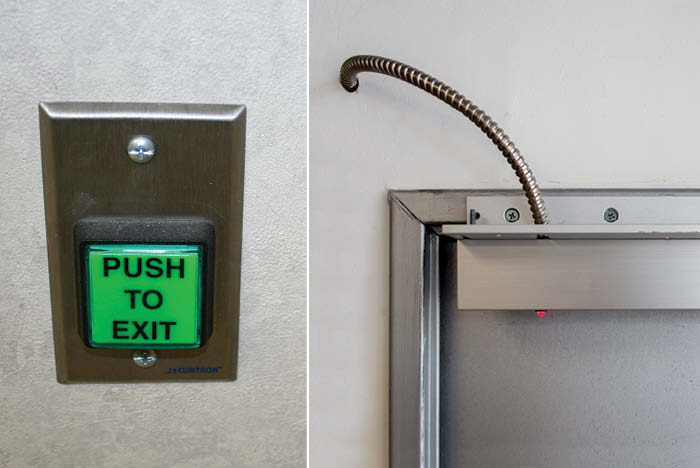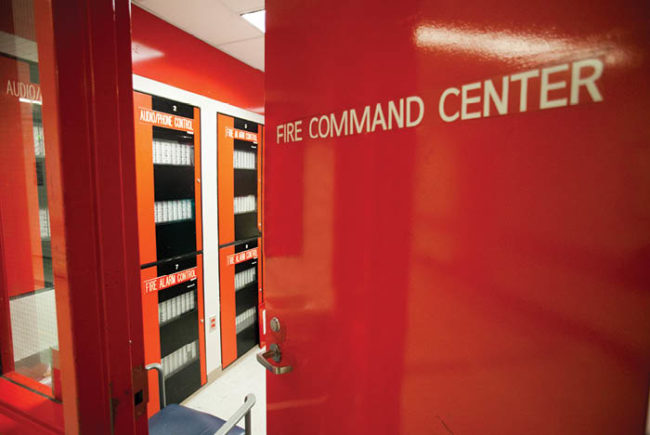
The 2018 edition of NFPA 101 now permits previously approved manual release devices serving magnetic locks to be located greater than 5 feet from the door opening.
Left image by Lennon Peake and right image by Getty Images
Health care organizations are currently required to comply with the 2012 edition of the National Fire Protection Association’s NFPA 101®, Life Safety Code® (LSC), as adopted in July 2016 by the Centers for Medicare & Medicaid Services (CMS).
However, there have been three subsequent editions of the LSC published since the 2012 edition that include numerous changes, many of which are beneficial to the health care field.
While CMS does not formally recognize the requirements in subsequent editions of the LSC, the provisions in the newer LSC editions can potentially be used to justify an equivalent level of life safety if the condition is cited during an accreditation or licensure survey.
This article focuses on the changes to the LSC since the 2012 edition that are beneficial to the health care field, as well as a few more restrictive changes that should be monitored. All code requirements discussed in this article remain in the 2021 edition of the LSC, although the sections referenced may be slightly different because they reference the section in the year in which the language entered the LSC.
Beneficial requirements
The changes that are most beneficial to health care facilities include several introduced in the 2015, 2018 and 2021 editions of the LSC.
For instance, LSC 2021, Table 19.1.6.1, added footnotes c and d, which address allowable construction types for nursing homes. Prior to CMS’s adoption of the LSC 2012, a nursing home with a noncompliant building construction type was able to pass an NFPA 101A-based fire safety evaluation system (FSES) analysis, which essentially deems the arrangement of safeguards in the building equivalent to LSC requirements.
The FSES scoring system changed to reflect the mandatory nursing home sprinkler protection requirement in 2008. The new provisions contained in the footnotes allow nursing homes that were capable of achieving equivalent compliance with LSC 2000 requirements per an FSES analysis to also achieve compliance with LSC 2021 if the appropriate life safety features are provided in the building.
A new term, “gross floor area (health care and ambulatory health care occupancies),” is defined in LSC 2021, section 3.3.22.2.3, which is applicable when calculating the area of smoke compartments and suites. The new definition no longer requires the inclusion of stairs and shafts within the boundary of smoke compartments or suites to be included in the area calculation.
This issue is likely to be resubmitted to the health care interpretations task force (HITF) and the new definition used as a justification for compliance to provide relief to health care facilities that currently have suites that are marginally oversized per LSC 2012 requirements. Revisions to suite size calculations may relax requirements regarding extent of smoke detection, use of quick-response sprinklers and direct supervision requirements.
Resources
Facilities have been required to perform annual fire door inspections even when they are located in barriers that are not required to have a fire-resistance rating, as the doors were interpreted to be a life safety feature “obvious to the public.” LSC 2021, section 4.6.12.4, no longer requires a door or door frame that is provided in barrier, which is not required to have a fire-resistance rating per the life safety plans, to comply with NFPA 80. This change alleviates the annual inspection and testing requirement of the door assembly. The door labels will no longer be required to be modified to avoid the annual inspection and testing requirement, per LSC 2021.
This issue is also likely to be resubmitted to the HITF in hopes of providing relief to the current enforcement of the provision. LSC 2015, section 8.3.3.3.4, moved text from the annex into the body of the code, which permits existing steel door frames without a label when the arrangement is permitted by the authority having jurisdiction (AHJ). It is not known if CMS will permit use of this language when a newer edition of the LSC is adopted now that the provision has been relocated into the body of the code.
LSC 2021, section 18/19.7.1.4, no longer requires transmission of the fire alarm signal during a fire drill. The previous LSC language was vague, and AHJs often interpreted the provision to require verification that the supervision station received the fire alarm signal during a quarterly fire drill, even though NFPA 72 only requires verification of supervision station transmission annually. LSC 2021, section 18/19.7.1.7, permits fire drills conducted during night shifts to use a coded announcement in lieu of activating the fire alarm system. Previously only audible notification devices and not visible notification devices were permitted to be substituted by the coded announcement.
The maximum allowable size of soiled linen and trash receptacles not located in hazardous area enclosures has increased from 32 gallons to 64 gallons per LSC 2021, section 18/19.7.5.7. This modification made the requirement consistent with the section 18/19.3.2.1 threshold for a room storing soiled linen or trash to be considered a hazardous area. Additionally, LSC 2018 removed the restriction limiting the capacity of containers within any 64-square-foot area.
LSC 2015, section 18/19.2.5.7.3.2, increased the maximum allowable area of patient care nonsleeping suites from 10,000 square feet to 15,000 square feet, depending on the life safety features provided in the suite. A maximum allowable area of 12,500 square feet is permitted, provided the smoke compartment containing the suite has standard-response sprinkler protection and total coverage smoke detection or fast-response sprinkler protection, per section 18/19.3.5.8.
A maximum allowable area of 15,000 square feet is permitted, provided the suite has fast-response sprinkler protection per section 18/19.3.5.8 and total coverage smoke detection. The changes in maximum allowable suite size are consistent with the increases permitted for patient care sleeping suites.
LSC 2018, section 18/19.3.7.1(1)(b), increased the maximum allowable size of hospital smoke compartments from 22,500 square feet to 40,000 square feet where the building is provided with fast-response sprinkler protection per section 18/19.3.5.8 and where all sleeping rooms in the smoke compartment (including suites) are configured for a single patient. The maximum allowable size of smoke compartments in nursing homes and long-term care facilities remains 22,500 square feet. LSC 2015, section 18/19.3.7.1(4), clarified that atriums designed in accordance with section 8.6.7 are not required to be subdivided by smoke barriers. Stories located below a health care occupancy are no longer required to be subdivided by smoke barriers per LSC 2018, section 18.3.7.2 (3).
On a related note, the code section is now clear that areas such as business occupancies on floors with a health care occupancy that are separated by two-hour fire-resistance-rated construction are not required to be subdivided by smoke barriers. It may still be prudent to provide smoke barriers in the business occupancy portion of the floor to minimize complications if the area were ever to be renovated into a health care occupancy because constructing a new smoke barrier in an existing building is extremely challenging.
LSC 2015, section 6.1.14.4.6, permits atrium walls to serve as an occupancy separation to create separate occupancies on a story-by-story basis provided the atrium boundary is constructed as a smoke partition with positive latching doors and provided with a smoke control system per section 8.6.8(5). This new requirement allows the atrium to separate a business occupancy from a health care occupancy without providing a two-hour fire-resistance-rated separation. This allowance is required to be approved by the occupancy chapter (health care, ambulatory health care and business occupancies all approve the arrangement).
LSC 2015, section 7.1.3.2.1(9)(a), clarified that a vestibule that is at minimum constructed as a smoke partition is permitted to separate a normally unoccupied space from an exit enclosure. This has been a common approach in building design and is now specifically approved by the code. LSC 2012, section 7.1.3.2.1(9)(c)(iii), permits existing mechanical equipment space to open directly into an exit enclosure, provided the room did not contain fuel-fired equipment, there was no storage of combustibles and the building was provided with complete sprinkler protection. In lieu of complete building sprinkler protection, LSC 2018 now allows an alternative to provide sprinkler protection and complete smoke detection in the mechanical equipment room only.
Penetrations into an exit enclosure for the security and communication system serving the exit are now permitted where the pathways are installed in metal conduit per LSC 2018, section 7.1.3.2.1(10)(c). The HITF issued an interpretation in June 2018 that permits penetrations into the exit enclosure for security systems and devices specifically mentioning card sensors, cameras and motion sensors.
LSC 2015, section 7.2.1.4.3.2, allows a fully open door leaf to project more than 7 inches into the required width of an aisle, corridor, passageway or landing, provided the door is equipped with a self-closer and does not serve a room where large occupant loads use the door. The annex states that the requirements are not intended to apply to doors from rooms that are typically unoccupied, such as janitor, electrical and telecommunication closets.
LSC 2015, section 7.7.2(1), states that not more than 50% of the required number of exit stairs serving each floor are permitted to discharge to the interior of the building (50% rule). The code language was clarified that the 50% rule is required to be met on each floor that is normally occupied. The 50% rule does not apply to a normally unoccupied mechanical penthouse that may only be served by a single exit stair that discharges to the interior of the building.
LSC 2018, section 7.7.2(3), added language that where an exit stair discharges to the interior of the building, exit signage identifiable from the point of exit discharge to the exterior of the building is a permittable alternative to the exit discharge leading to a free and unobstructed way to the exterior of the building. Many local AHJs applying the International Building Code may provide a different interpretation, so it is important to clarify design intent with all applicable parties.
Finally, LSC 2015 no longer requires areas in ambulatory health care occupancies greater than 2,500 square feet to be provided with two means of egress. (Note that LSC 2021, section 18/19.2.5.5.2, still has the requirement for health care occupancies.) Also, previously approved stair identification signs that are required for exit stairs that serve five or more stories are no longer required to comply with the dimensional criteria for lettering per LSC 2015, section 7.2.2.5.4.1(P).
Restrictive requirements
In contrast to those discussed thus far, there also are changes in the 2015 and 2018 editions of the LSC that will result in more restrictive requirements.
For instance, LSC 2015, sections 18/19.2.5.7.2.4(A) and 18/19.2.5.7.3.3(A), clarified that the maximum suite travel distance of 100 feet is to be measured to an exit access door to another suite, to an exit access corridor door or a horizontal exit. The 2012 edition merely stated that the distance must be measured to an “exit access door.”
Suite travel distance should be measured to an interior exit access corridor/suite door or horizontal exit due to the defend-in-place strategy used in hospitals during fire events. Relocating patients to the exterior of the building poses a serious risk during times of extreme temperature and weather. It is also desirable to keep patients in the building during horizontal evacuation to ensure heath care delivery is not adversely affected.
LSC 2018, section 18.2.4.4.2, requires that a smoke barrier door must not serve as the only exit access from any space in a smoke compartment. This requirement, which only applies to new health care occupancies, prohibits a smoke barrier from being run across the wall of a room with a single exit access door. Best practice has always been to locate the smoke barrier along the walls that do not contain the door to the room, and now this approach is in the LSC.
LSC 2015, section 20/21.2.4.4, added the language that egress from smoke compartments is permitted through adjacent smoke compartments, provided that the two required egress paths do not pass through the same adjacent smoke compartment. This new ambulatory health care requirement is consistent with the health care occupancy requirements.
LSC 2018, section 18/19.3.6.3.1, moved the language from the annex into the body of the code that the corridor door latching provisions must be applied to nurse servers and pass-through openings in corridor walls. The section also details door clearance requirements, which are slightly different for new and existing health care occupancies. LSC 2018, sections A.18.3.6.1(2) and A.19.3.6.1(3), added language to the annex related to the omission of smoke detection in nurses stations open to the corridor.
The new annex language states that the omission of smoke detection does not pertain to nurses stations that are not continuously staffed as there is not early detection by staff in the areas during off hours. These satellite nurses stations must be provided with smoke detection if the area is not separated from the corridor or continuously staffed.
Knowledge is power
While the code requirements discussed in this article are not currently enforced by CMS, the language could be useful to justify an existing condition that would be costly to remediate to LSC 2012 requirements.
Familiarity with the new requirements also provides advance knowledge for when the next edition of the LSC is adopted by CMS.
Finally, understanding the differences between the 2012 edition and more recent editions is important for renovations and new construction because AHJs typically enforce more recent editions of the LSC.
Lennon Peake, PE, SASHE, is director and Allison C. Ellis, PE, is project manager at Koffel Compliance LLC, Columbia, Md. They can be reached at lpeake@koffelcompliance.com and aellis@koffelcompliance.com.





